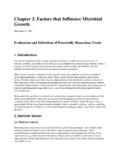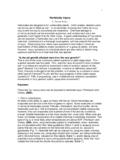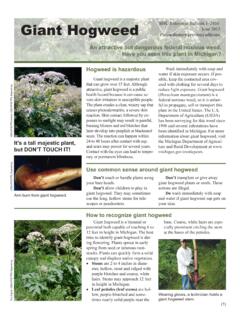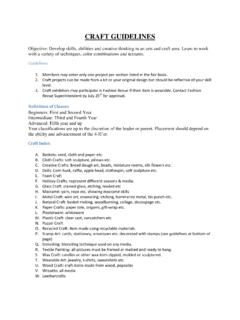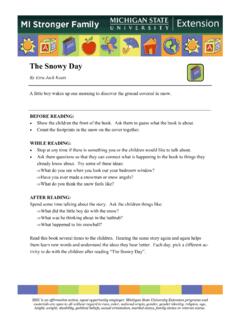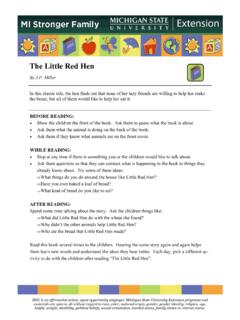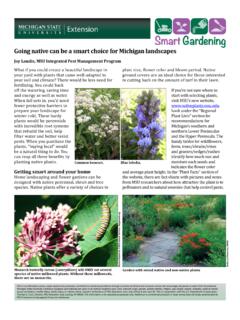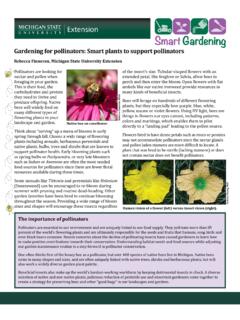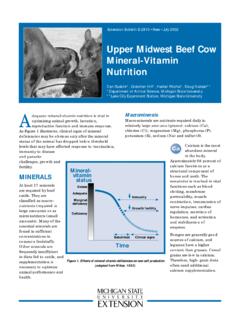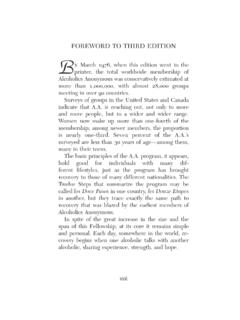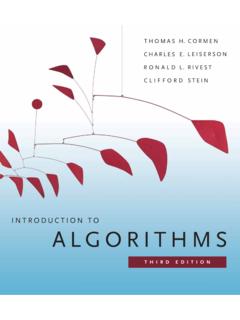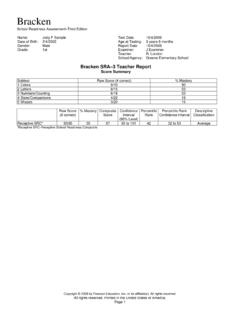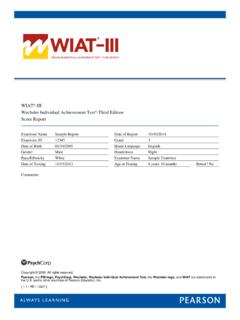Transcription of Field Guide for - MSU Extension
1 Field Guide for Integrated Pest Management in HopsThird edition 2015A Cooperative Publication Produced by Washington State University,Oregon State University, University of Idaho, and Department of Agriculture in cooperation with Michigan State University and Cornell UniversityCoordination, Copyediting, and Graphic DesignSally D. O NealIrrigated Agriculture Research and Extension CenterWashington State University, Prosser, WATechnical EditorsDouglas B. Walsh, Senior Technical Editor, third EditionIrrigated Agriculture Research and Extension CenterWashington State University, Prosser, WA David H. Gent, Senior Technical Editor, First and Second EditionsUnited States Department of Agriculture, Agricultural Research Service, andOregon State University, Corvallis, ORJames D.
2 BarbourSouthwest Idaho Research and Extension Center University of Idaho, Parma, IDRick A. BoydstonIrrigated Agriculture Research and Extension CenterUSDA Agricultural Research Service, Prosser, WAAnn E. GeorgeHop Growers of America, Hop Growers of Washington, Hop Industry Plant Protection Committee, and Washington Hop Commission, Moxee, WADavid G. JamesIrrigated Agriculture Research and Extension CenterWashington State University, Prosser, WAJ Robert SirrineCommunity Food Systems EducatorMichigan State University Extension , Suttons Bay, MIContributorsAmerican Phytopathological Society, St. Paul, MNCraig R. Baird, SIREC, UI, Parma, IDDez J. Barbara, Horticulture Research International, Warwick, United KingdomJames D. Barbour, SIREC, UI, Parma, IDRon A. Beatson, HortResearch, Motueka, New ZealandGeorge W.
3 Bird, MSU, MIRick A. Boydston, USDA-ARS, Prosser, WAVicky Brewster, Illustrator Deborah J. Tora Brooks, IAREC, WSU, Prosser, WALilian B. Calderwood, University of Vermont, Burlington, VTCenter for Invasive Species and Ecosystem Health (formerly Bugwood Network), University of Georgia, Tifton, GANatasha R. Cerruti, Purdue University, West Lafayette, INHeather M. Darby, University of Vermont, St. Albans, VTAmy J. Dreves, OSU, Corvallis, ORKenneth C. Eastwell, IAREC, WSU, Prosser, WABernhard Engelhard, Bavarian State Research Center for Agriculture, Wolnzach, GermanyMelanie Filotas, Ontario Ministry of Agriculture, Food and Rural Affairs, Canada Glenn C. Fisher, OSU, Corvallis, ORJoel Floyd, Illustrator, M. Gadoury, Cornell University, Geneva, NYDavid H. Gent, USDA-ARS and OSU, Corvallis, ORAmanda J.
4 Gevens, University of Wisconsin, Madison, WIMargaret A. Goll, MSU, East Lansing, MIChelsea A. Gordon, The Ohio State University, Wooster, OHKen Gray Image Collection, OSU, Corvallis, ORDaniel P. Groenendale, IAREC, WSU, Prosser, WAMary K. Hausbeck, MSU, East Lansing, MIFrank S. Hay, Cornell University, Geneva, NYDavid G. James, IAREC, WSU, Prosser, WADennis A. Johnson, WSU, Pullman, WAAcknowledgementsFunding for this Field Guide was made by possible by grants from the Western IPM Center and the Brewers Association. Financial support also was provided by Oregon Hop Commission, Oregon State University, Michigan State University, University of Idaho, Department of Agriculture Agricultural Research Service, Washington Hop Commission, and Washington State University. This material is based upon work that is supported by the National Institute of Food and Agriculture, Department of Agriculture, under Specialty Crop Research Initiative award numbers 2009-51181-05790 and 2014-51181-22381.
5 Any opinions, findings, conclusions, or recommendations expressed in this publication are those of the authors and do not necessarily reflect the view of the Department of editors gratefully acknowledge the many reviewers and authors who contributed to this publication. We also recognize the hop industry for its continued support of research, Extension , integrated pest management, and environmental in this publication to a trademark, proprietary product, or company name by personnel of the Department of Agriculture or anyone else is intended for explicit description only and does not imply approval or recommendation to the exclusion of others that may be rights reserved. No portion of this book may be reproduced in any form, including photocopy, microfilm, information storage and retrieval system, computer database, or software, or by any means, including electronic or mechanical, without written permission from the Hop Growers of is not claimed in any portion of this work written by government employees as a part of their official duties.
6 2015 Hop Growers of AmericaErin Lizotte, MSU Extension , Cadillac, MIWalter F. Mahaffee, USDA-ARS, Corvallis, ORTrish McGee, Sustainability Victoria, Melbourne, Victoria, AustraliaThomas M. Mowry, UI, IDTom Murray, Author of Insects of New England and New YorkMark E. Nelson, IAREC, WSU, Prosser, WAJohn L. Obermeyer, Purdue University, West Lafayette, INCynthia M. Ocamb, OSU, Corvallis, ORSally D. O Neal, IAREC, WSU, Prosser, WARobert Parker, IAREC, WSU, Prosser, WASarah J. Pethybridge, Cornell University, Geneva, NYChristopher R. Philips, University of Minnesota, Grand Rapids, MNTara G. Piraneo, IAREC, WSU, Prosser, WAJohann Portner, Bavarian State Research Center for Agriculture, Wolnzach, GermanyBeth Price, L. Putnam, OSU, Corvallis, ORSebastjan Radi ek, Slovenian Institute for Hop and Breeding, alec, SloveniaCharlie L.
7 Rohwer, University of Minnesota, SROC, Waseca, MNDave Sbur, Trident Agricultural Products, Woodland, WAJ Robert Sirrine, MSU Extension , Suttons Bay, MICal B. Skotland, IAREC, WSU, Prosser, WADarrell R. Smith, Busch Agricultural Resources, Inc., Yakima, WAJulien Venne, Professional Agronomy Consultant, Quebec, CanadaDouglas B. Walsh, IAREC, WSU, Prosser, WAFred W. Warner, MSU, MIFlorian Weihrauch, Bavarian State Research Center for Agriculture, Wolnzach, GermanyPaul J. Werner, MSU Extension , L Anse, MIDoug Whitener, Long, Yakima, WASierra N. Wolfenbarger, OSU, Corvallis, ORJoanna L. Woods, OSU, Corvallis, ORLarry C. Wright, IAREC, WSU, Prosser, WABernard H. Zandstra, MSU, East Lansing, MIAbbreviations: IAREC = Irrigated Agriculture Research and Extension CenterMSU = Michigan State UniversityOSU = Oregon State UniversitySIREC = Southwest Idaho Research and Extension CenterSROC = Southern Research and Outreach CenterUSDA-ARS = United States Department of Agriculture, Agricultural Research ServiceUI = University of IdahoWSU = Washington State UniversityTable of Contents IntroductionBackground, Purpose, and Use of This Guide .
8 1 Principles of Integrated Pest Management ..2 Pesticide Toxicology and SelectivityPesticide Toxicity Ratings ..6 Pesticide Resistance Management ..8 Disease ManagementFungal and Bacterial DiseasesAlternaria Cone Disorder ..12 Black Root Rot ..14 Downy Mildew ..15 Fusarium Canker ..22 Fusarium Cone Tip Blight ..23 Gray Mold ..24 Powdery Mildew ..25 Red Crown Rot ..30 Sclerotinia Wilt (White Mold) ..32 Sooty Mold ..33 Verticillium Wilt ..34 Diseases of Minor Importance ..36 Virus and Viroid DiseasesCarlavirus Complex ..38 Apple mosaic virus ..39 Hop stunt viroid ..40 Other Viruses, Viroids, and Virus-like Agents ..42 Abiotic DiseasesHeptachlor Wilt ..44 Nematodes ..45 Arthropod and Mollusk ManagementAphids ..47 Beetles California Prionus Beetle ..49 Hop Flea Beetle.
9 51 Japanese Beetle ..52 Root Weevils ..54 Rose Chafer ..55 Western Spotted Cucumber Beetle ..56 Garden Symphylan ..57 Leafhoppers ..59 Lepidopteran Larvae (Caterpillars) ..60 Mites ..66 Slugs and Snails ..70 Beneficial Arthropods and PathogensIntroduction ..71 Predatory Mites ..72 Predatory Lady Beetles ..74 Predatory Bugs ..78 Parasitic Wasps (Parasitoids) ..81 Parasitic and Predatory Flies ..82 Pathogens ..83 Predatory Thrips ..84 Snakeflies and Lacewings ..84 Spiders ..86 Weed ManagementIntroduction ..87 Planning a Weed Management Program ..88 Prevention ..88 Weed Seedling Identification ..89 Cultural (Non-Chemical) Tactics ..90 New Hop Yards ..91 Herbicides ..92 Calculating Treated Acres versus Sprayed Acres ..95 Herbicide Injury ..96 Nutrient Management and Imbalances.
10 98 Resources ..101 Index ..102 TablesTable 1. Signal Words and Relative Impact on Non-target Beneficial Arthropods of Pesticides Registered for Use on Hop ..7 Table 2. Modes of Action and Resistance Codes for Pesticides Used on Hop ..11 Table 3. Disease Susceptibility and Chemical Characteristics of the Primary Public Hop Varieties Grown in the ..18 Table 4. Approximate Period of Protection for Selected Downy Mildew Fungicides ..20 Table 5. Efficacy Ratings for Weed Management Tools in Hop ..93 Table 6. Common Symptoms of Herbicide Injury on Hop ..96 Use pesticides with care. Apply them only to plants, animals, or sites listed on the label. When mixing and applying pesticides, follow all label precautions to protect yourself and others around you. It is a violation of the law to disregard label directions.
